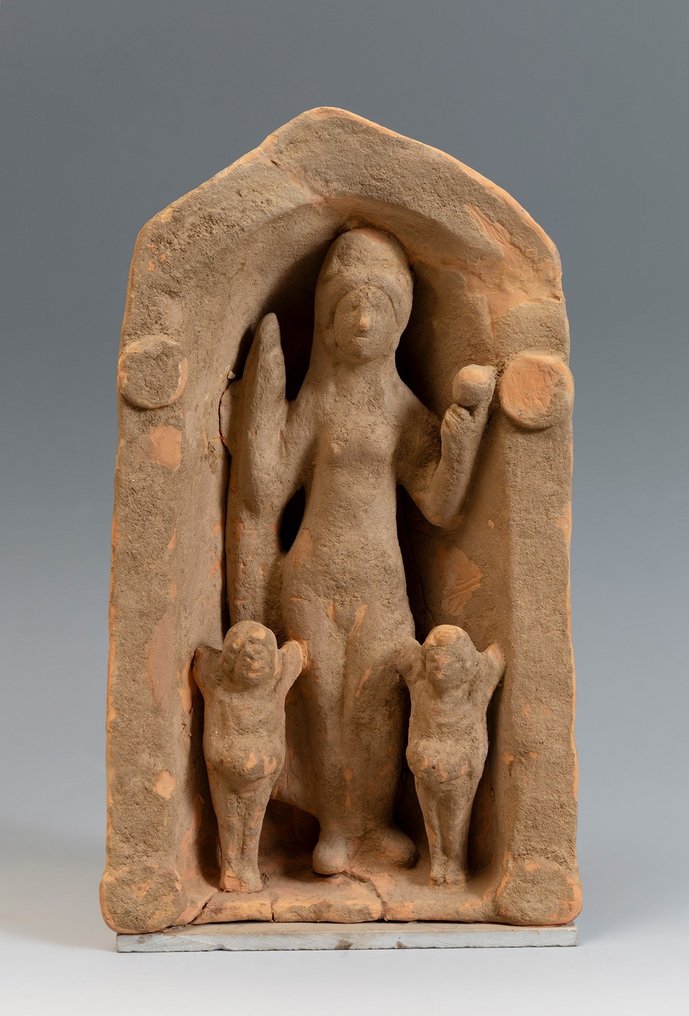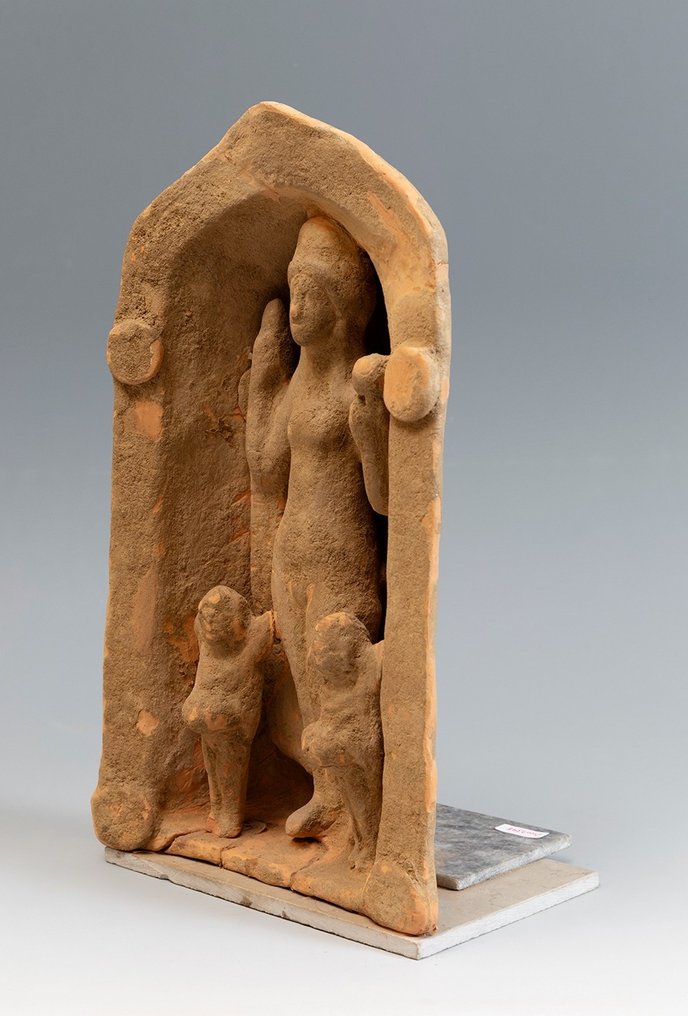Perfect
Übersetzung ansehenAltgriechisch Terracotta Schöne Stele der Liebesgöttin Aphrodite - Venus mit zwei Eros - Amoren. 27 cm H. Spanischer Export
Nr. 90095177



Nice and pretty stela of goddess of love Aphrodite - Venus with two Eros - Cupid
Venus Chastising Cupid
Ancient Greek, 4th - 2nd century BC
27 heigth and 15 cm large.
PROVENANCE: Private collection Mr. L., south of France, before 1980. Old label in the back.
CONDITION: Good, onlye a breakline in the up of the temple see photos.
DESCRIPTION:
In this intimate sculptural portrayal of a relationship between two divinities, Aphrodite playfully threatens her mischievous son, Eros. The goddess of love wears a stephane--a crown--over her cascading hair and holds a folded cestus--a girdle--just above her shoulder, ready to slap her son. Eros--his wings fully extended--playfully holds up his hand to protect himself.
This scene represents a divine counterpart to the everyday closeness between a mortal mother and her son. During the Hellenistic era, gods and goddesses were often portrayed in a more personal way. This method of representation was a dramatic departure from the earlier Classical style, when the gods were represented more formally as gods, rather than as lighthearted--and humanlike--creatures.
Aphrodite was the goddess of beauty, love and fertility, embodying the primal forces of creation. From the 3rd century BC, she was identified with Venus by the Romans, their local divinity related to the same forces. The goddess, according to Hesiod, was born from foam – the sperm – in the surrounding sea which came from the cut-off genitals of Uranus. In the origins of the Universe, Uranus (the Heavens) mated with Gea (the Earth), engendering various children. But out of fear that they would take the throne from him, he kept them imprisoned in the body of their mother. Cronus, tired of this situation, managed to gain power, castrating his own father and throwing the genitals into the sea:
“From out of the foam a young woman was born. At first, she floated ashore towards the divine Cythera and from there she went to Cyprus… The august and beautiful goddess emerged from the sea, and around her delicate feet grew grass. (…) At first when she was born, and later when she went to join the body of the gods, Eros accompanied her as did the handsome Himeros. And she possessed these attributes (…): intimacy with young maidens, smiles, deceptions, sweet pleasure, love and tenderness.”
Eros, in Greek religion, god of love. In the Theogony of Hesiod (fl. 700 BCE), Eros was a primeval god, son of Chaos, the original primeval emptiness of the universe, but later tradition made him the son of Aphrodite, goddess of sexual love and beauty, by either Zeus (the king of the gods), Ares (god of war and of battle), or Hermes (divine messenger of the gods). Eros was a god not simply of passion but also of fertility. His brother was Anteros, the god of mutual love, who was sometimes described as his opponent. The chief associates of Eros were Pothos and Himeros (Longing and Desire). Later writers assumed the existence of a number of Erotes (like the several versions of the Roman Amor). In Alexandrian poetry he degenerated into a mischievous child. In Archaic art he was represented as a beautiful winged youth but tended to be made younger and younger until, by the Hellenistic period, he was an infant. His chief cult centre was at Thespiae in Boeotia, where the Erotidia were celebrated. He also shared a sanctuary with Aphrodite on the north wall of the Acropolis at Athens. Cupid, ancient Roman god of love in all its varieties, the counterpart of the Greek god Eros and the equivalent of Amor in Latin poetry. According to myth, Cupid was the son of Mercury, the winged messenger of the gods, and Venus, the goddess of love. He often appeared as a winged infant carrying a bow and a quiver of arrows whose wounds inspired love or passion in his every victim. He was sometimes portrayed wearing armour like that of Mars, the god of war, perhaps to suggest ironic parallels between warfare and romance or to symbolize the invincibility of love.
Notes:
- The piece includes authenticity certificate.
- The piece includes Spanish Export License (Passport for European Union) - If the piece is destined outside the European Union a substitution of the export permit should be requested, can take between 1-2 weeks maximum.
- The seller guarantees that he acquired this piece according to all national and international laws related to the ownership of cultural property. Provenance statement seen by Catawiki.
#ancientcivilisations
Der Verkäufer stellt sich vor
Nice and pretty stela of goddess of love Aphrodite - Venus with two Eros - Cupid
Venus Chastising Cupid
Ancient Greek, 4th - 2nd century BC
27 heigth and 15 cm large.
PROVENANCE: Private collection Mr. L., south of France, before 1980. Old label in the back.
CONDITION: Good, onlye a breakline in the up of the temple see photos.
DESCRIPTION:
In this intimate sculptural portrayal of a relationship between two divinities, Aphrodite playfully threatens her mischievous son, Eros. The goddess of love wears a stephane--a crown--over her cascading hair and holds a folded cestus--a girdle--just above her shoulder, ready to slap her son. Eros--his wings fully extended--playfully holds up his hand to protect himself.
This scene represents a divine counterpart to the everyday closeness between a mortal mother and her son. During the Hellenistic era, gods and goddesses were often portrayed in a more personal way. This method of representation was a dramatic departure from the earlier Classical style, when the gods were represented more formally as gods, rather than as lighthearted--and humanlike--creatures.
Aphrodite was the goddess of beauty, love and fertility, embodying the primal forces of creation. From the 3rd century BC, she was identified with Venus by the Romans, their local divinity related to the same forces. The goddess, according to Hesiod, was born from foam – the sperm – in the surrounding sea which came from the cut-off genitals of Uranus. In the origins of the Universe, Uranus (the Heavens) mated with Gea (the Earth), engendering various children. But out of fear that they would take the throne from him, he kept them imprisoned in the body of their mother. Cronus, tired of this situation, managed to gain power, castrating his own father and throwing the genitals into the sea:
“From out of the foam a young woman was born. At first, she floated ashore towards the divine Cythera and from there she went to Cyprus… The august and beautiful goddess emerged from the sea, and around her delicate feet grew grass. (…) At first when she was born, and later when she went to join the body of the gods, Eros accompanied her as did the handsome Himeros. And she possessed these attributes (…): intimacy with young maidens, smiles, deceptions, sweet pleasure, love and tenderness.”
Eros, in Greek religion, god of love. In the Theogony of Hesiod (fl. 700 BCE), Eros was a primeval god, son of Chaos, the original primeval emptiness of the universe, but later tradition made him the son of Aphrodite, goddess of sexual love and beauty, by either Zeus (the king of the gods), Ares (god of war and of battle), or Hermes (divine messenger of the gods). Eros was a god not simply of passion but also of fertility. His brother was Anteros, the god of mutual love, who was sometimes described as his opponent. The chief associates of Eros were Pothos and Himeros (Longing and Desire). Later writers assumed the existence of a number of Erotes (like the several versions of the Roman Amor). In Alexandrian poetry he degenerated into a mischievous child. In Archaic art he was represented as a beautiful winged youth but tended to be made younger and younger until, by the Hellenistic period, he was an infant. His chief cult centre was at Thespiae in Boeotia, where the Erotidia were celebrated. He also shared a sanctuary with Aphrodite on the north wall of the Acropolis at Athens. Cupid, ancient Roman god of love in all its varieties, the counterpart of the Greek god Eros and the equivalent of Amor in Latin poetry. According to myth, Cupid was the son of Mercury, the winged messenger of the gods, and Venus, the goddess of love. He often appeared as a winged infant carrying a bow and a quiver of arrows whose wounds inspired love or passion in his every victim. He was sometimes portrayed wearing armour like that of Mars, the god of war, perhaps to suggest ironic parallels between warfare and romance or to symbolize the invincibility of love.
Notes:
- The piece includes authenticity certificate.
- The piece includes Spanish Export License (Passport for European Union) - If the piece is destined outside the European Union a substitution of the export permit should be requested, can take between 1-2 weeks maximum.
- The seller guarantees that he acquired this piece according to all national and international laws related to the ownership of cultural property. Provenance statement seen by Catawiki.
#ancientcivilisations
Der Verkäufer stellt sich vor
- 829
- 9
- 2
Thank you, everything was perfect!
Übersetzung ansehenpiezas muy interesantes. Todo muy correcto, como siempre.
Übersetzung ansehenestoy muy agradecida por como han tenido tanto tacto y cuidado en enviar la figura protegida, su certificado de autenticidad es muy profesional, al igual que su atención y trato con el cliente
Übersetzung ansehenEl vendedor cumple lo prometido, el objeto es de alta calidad, entonces estoy muy satisfecho con mi compra, muchas gracias.
Übersetzung ansehenPerfect!
Übersetzung ansehenI just love the mood in this picture! I’m not even a cat-person. Seller was nice and made sure to ship it on a certain date, since i was traveling. I’m very happy with my purchase 🐱🤩 thank you!
Übersetzung ansehenAll good, thank you !
Übersetzung ansehenAll good, thank you !
Übersetzung ansehenOne item was missing, one was damaged. Photos sent as requested. After that, no more communication even when asked. Too bad!
Übersetzung ansehenmerci, jolie bijou.
Übersetzung ansehenIk heb het goed en snel ontvangen. Het ziet er goed uit. Ben er blij mee.
Übersetzung ansehenGreat seller!!
Übersetzung ansehenBagot siempre rápido y fiable, muchas gracias
Übersetzung ansehengreat scarab! very fast shipping! thank you very much!
Übersetzung ansehenTodo bien. Vendedor recomendado.
Übersetzung ansehenAbsolut vertrauenswürdiger Händler ! Und: ein ganz zauberhaftes Stück !
Übersetzung ansehenOttimo imballo particolare come da foto
Übersetzung ansehenTodo bien. Persona muy amable y atenta. Recomendado.
Übersetzung ansehenTodo bien. Vendedor muy amable y atento. Recomendado.
Übersetzung ansehenTodo bien. Persona muy amable y atenta. Vendedor recomendado.
Übersetzung ansehenTodo bien. Envío muy cuidado, de auténtico profesional. Persona, además, muy amable y atenta. Vendedor recomendado.
Übersetzung ansehena recommander envoi tres rapide est sécurisé embalage tres bien fait vraiment rien a dire plus que parfait
Übersetzung ansehenBeautiful objects! Extremely fast shipment! I can fully recommend this seller.
Übersetzung ansehenwonderful apis!very fast shipping!thanks a lot
Übersetzung ansehenDisclaimer
Der Verkäufer garantiert und kann belegen, dass das Objekt legal erworben wurde. Der Verkäufer wurde von Catawiki darüber informiert, dass er die Unterlagen, die gemäß den Gesetzen und Vorschriften seines Landes erforderlich sind, zur Verfügung stellen muss. Der Verkäufer garantiert, dass er berechtigt ist, das Objekt zu verkaufen/auszuführen. Der Verkäufer wird dem Käufer alle Informationen, die zur Provenienz des Objekts vorliegen, zur Verfügung stellen. Der Verkäufer versichert, dass alle erforderlichen Genehmigungen eingeholt wurden/werden. Der Verkäufer wird den Käufer unverzüglich über etwaige Verzögerungen bei der Einholung dieser Genehmigungen informieren.
Der Verkäufer garantiert und kann belegen, dass das Objekt legal erworben wurde. Der Verkäufer wurde von Catawiki darüber informiert, dass er die Unterlagen, die gemäß den Gesetzen und Vorschriften seines Landes erforderlich sind, zur Verfügung stellen muss. Der Verkäufer garantiert, dass er berechtigt ist, das Objekt zu verkaufen/auszuführen. Der Verkäufer wird dem Käufer alle Informationen, die zur Provenienz des Objekts vorliegen, zur Verfügung stellen. Der Verkäufer versichert, dass alle erforderlichen Genehmigungen eingeholt wurden/werden. Der Verkäufer wird den Käufer unverzüglich über etwaige Verzögerungen bei der Einholung dieser Genehmigungen informieren.